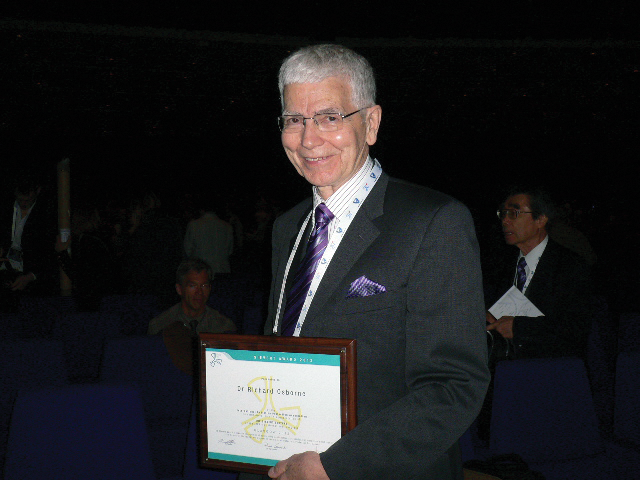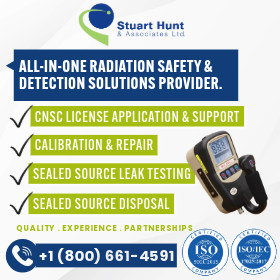From the Archives: CRPA’s First Honorary Lifetime Member – Dr. Richard Osborne
In honour of CRPA’s 45th anniversary, we thought it was fitting to look back at the man who started it all back in 1979. In 2008, CRPA established an honorary lifetime membership and conferred the first such membership on Dr. Richard Osborne, CRPA’s founder and first president. Following is an article that we published about this in a special “double issue” of the CRPA Bulletin in the fall of 2008 (Vol 29, No 2 & 3).
At the 2008 CRPA Annual General Meeting on June 4, a motion was passed to establish an honorary lifetime membership category. Most appropriately, the first such membership was later conferred on Dr. Richard Osborne, CRPA’s founder and first president.
To become an honorary life member, those nominated must (1) have been full members of CRPA for at least 10 consecutive years and (2) be nominated by at least two full members for significant contribution to the field of radiation protection or to CRPA. Richard Osborne was nominated by Steve Webster and Merlin Seier, who, in their nomination letter, said it was “icing on the cake to induct this new category’s first member at the closing ceremonies of the conference rather than waiting a year.”
Richard Osborne received his BA (Honours) in natural sciences from Cambridge University in 1959. He undertook postgraduate research with Professor W. V. Mayneord at the Institute of Cancer Research in London, England, gaining his PhD in biophysics from London University in 1962. He then accepted a research fellowship with Dr. M. Eisenbud at the Institute of Environmental Medicine at the New York Medical Center.
In 1963, Dr. Osborne joined Atomic Energy of Canada Limited (AECL) at Chalk River, Ontario, as a research officer in the Health Physics Branch. He was appointed manager of the Environmental Research Branch at Chalk River Laboratories (CRL) in 1981. In July 1988, he accepted a special assignment as executive assistant to the president of the AECL Research Company.
Dr. Osborne returned to CRL in November 1989 as director of the Health and Environmental Sciences Division. From 1991 to 1994, he was not only responsible for all occupational safety and health-protection programs in AECL Research but also headed the research program in health sciences. From 1994 until he retired from AECL in 1998, he directed the organization’s research programs in radiation biology, health physics, and environmental research. In addition to chairing the AECL Health and Environment Working Group, he served on both its Safety Review Committee and Environmental Panel.
[When this article was originally published, Dr. Osborne was president of Ranasara Consultants Inc. and worked in the general area of radiological protection.]Dr. Osborne has been honoured by and served on an impressive array of radiation-protection organizations, both nationally and internationally. He received the Elda E. Anderson Award of the Health Physics Society in 1975 and was a member of the society’s board of directors from 1976 to 1979. In 1992, he was the society’s G. William Morgan Lecturer and, in 2004, the Robert S. Landauer Lecturer. Dr. Osborne was elected as a fellow of the society in 2005.
Dr. Osborne founded CRPA in 1979 and was its first president. He was vice-president of the International Radiation Protection Association from 1992 to 1996. He served on Committee 4 of the International Commission on Radiological Protection (ICRP) from 1980 to 1993 and again from 1997 to 2001, the second time as its vice-chairman. He chaired the ICRP Task Group on Radon in Buildings in 1989 and the Working Party on Controllable Dose from 1997 to 2001.
As well as working with various Canadian agencies, including the Advisory Committee on Radiological Protection of the Canadian Nuclear Safety Commission, Dr. Osborne has been involved with a number of international organizations:
- the Nuclear Energy Agency (NEA), a specialized agency within the Organization for Economic Co-operation and Development (OECD), based in Paris, France;
- the National Council on Radiation Protection and Measurements (NCRP) in the United States; and the International Atomic Energy Agency in Vienna, Austria (including the Radiation Safety Standards Advisory Committee).
He has also been involved internationally as
- a member of the United States National Research Council’s Committee on Radiological Safety in the Marshall Islands;
- the Canadian representative to United Nations Scientific Committee on the Effects of Atomic Radiation (UNSCEAR) in 1996 and 1997;
- the task leader for Tritium Safety and Environmental Effects for the International Energy Agency (IEA) Implementing Agreement on Environmental, Safety and Economic Aspects of Fusion Power in 1997; and
- a member of the Research Advisory Committee for the National Institute of Radiological Sciences in Japan in the late 1990s.
Dr. Osborne’s early research and papers were on the behaviour and measurement of natural radioactivity in the biosphere. He later led a research and development program on tritium health physics, which resulted in many papers on topics ranging from biokinetics to instrumentation to operational protection. His work for various agencies included the responsibility for writing and editing many reports on the practical application of radiological-protection principles.
Nominations for honorary life membership must be submitted to the CRPA Secretariat at least three months prior to the Annual General Meeting. Supporting documentation should include a short biography of the candidate and reasons for the nomination. For more information about the nomination process, please contact the CRPA Secretariat.
Do you want to read more articles like this?
The Bulletin is published by the Canadian Radiation Protection Association (CRPA). It’s a must-read publication for radiation protection professionals in Canada. The editorial content delivers the insights, information, advice, and valuable solutions that radiation protection professionals need to stay at the forefront of their profession.
Sign up today and we’ll send you an email each time a new edition goes live. In between issues, check back often for updates and new articles.
Don’t miss an issue. Subscribe now!
Subscribe








![12th Annual CRPA Conference and Radiation Protection Symposium in Winnipeg, MB, June 16–21, 1991. Standing, left to right: Dave Sliney (US Army Environmental Hygiene Agency), John Auxier (International Technology (IT) Corporation’s Radiological Sciences Laboratory, Oak Ridge, TN; president, Health Physics Society 1977–78), Charles Meinhold (National Council on Radiation Protection and Measurements [NCRP]; president, Health Physics Society 1981–82), Richard Osborne (head, Health Sciences Division, Atomic Energy of Canada Limited [AECL], Chalk River, ON), Robin Mole (Oxford University), Ernest Letourneau (director, Bureau of Radiation and Medical Devices, Health and Welfare Canada). Seated, left to right: Irv Gusdal (University of Manitoba), Karin Gordon (radiation safety officer, Health Sciences Centre, Winnipeg, MB), Danny Buksak (University of Manitoba). Missing: John Waddington (Atomic Energy Control Board [AECB]). a row of 6 older white men wearing suits and ties standing behind 3 people who are seated in front of them: an older blind man on the left, a dark haired woman in the middle, and a dark-haired man on the right. At the bottom of the picture is a white box with typed caption](https://crpa-acrp-bulletin.ca/wp-content/uploads/2024/06/Winnipeg-1991-720x584-640x480.png)










